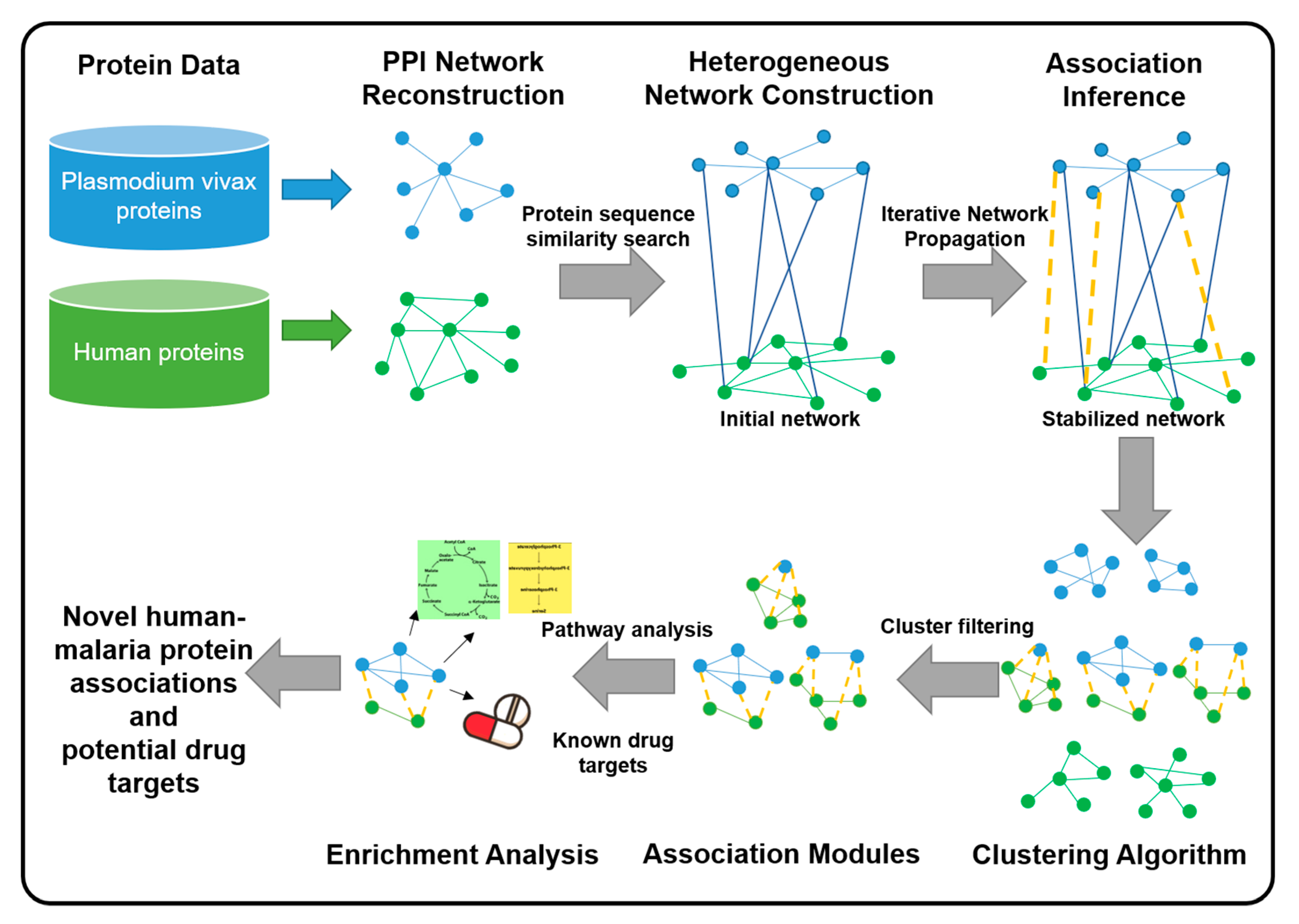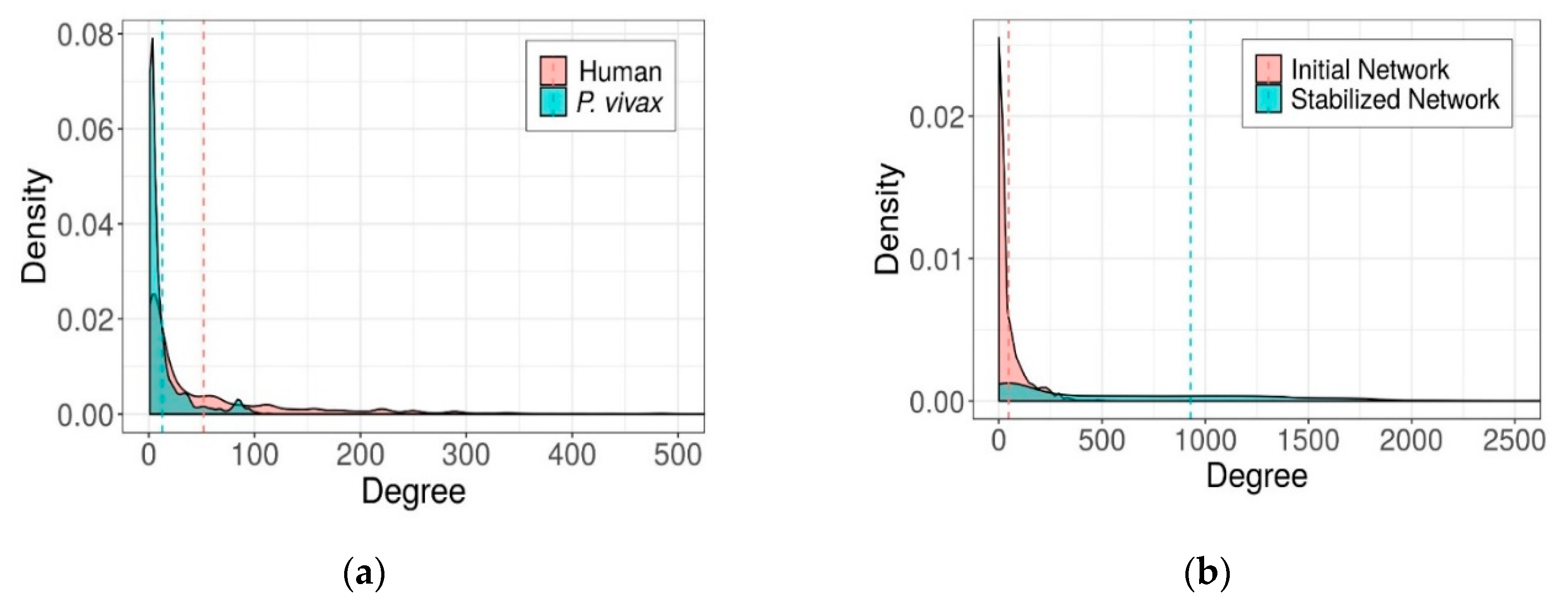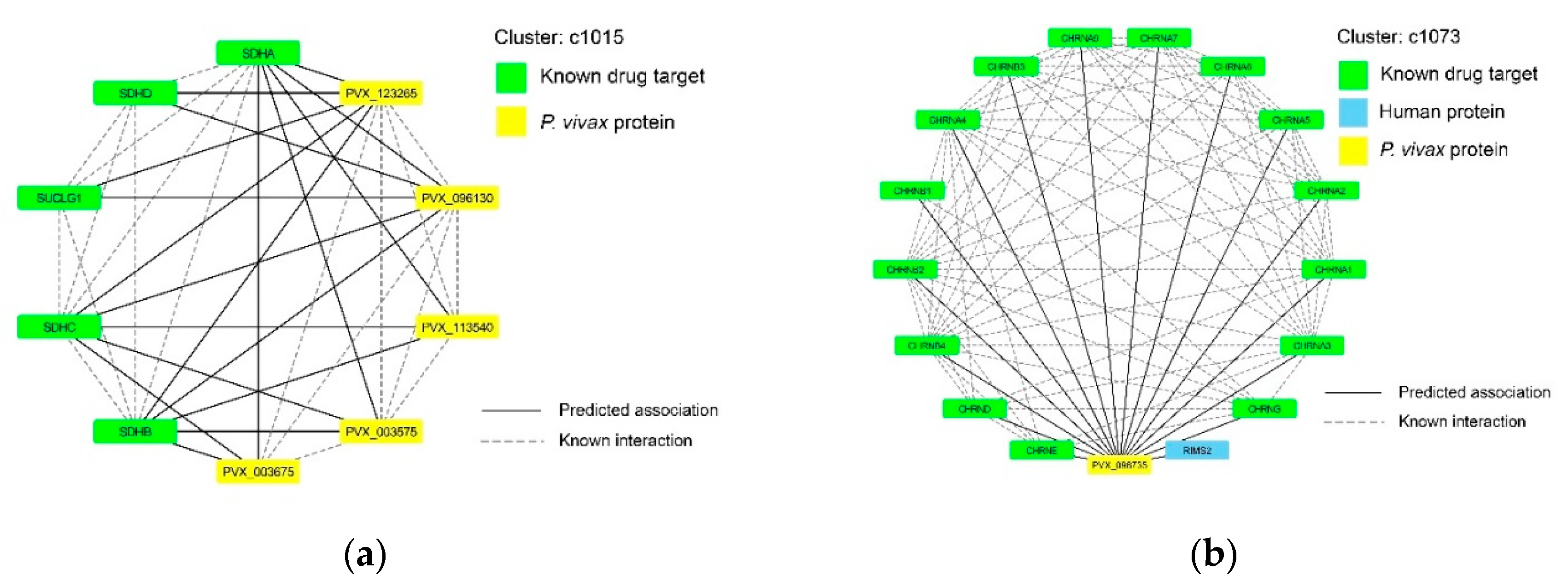Heterogeneous Network Model to Identify Potential Associations Between Plasmodium vivax and Human Proteins
Abstract
:1. Introduction
2. Results
2.1. Initial and Stabilized Heterogeneous Networks
2.2. Performance in Identifying Human-Malaria Protein Associations
2.3. Association Modules and Protein Complexes on the Heterogeneous Network
2.4. Identification of Potential Drug Targets in Humans to Treat Malaria
2.4.1. Potential Targets of Succinate Dehydrogenase Complex
2.4.2. Potential Targets of Nicotinic Acetylcholine Receptor
3. Discussion
4. Materials and Methods
4.1. Datasets
4.1.1. Protein Interaction Information
4.1.2. Protein Sequence Similarity Information
4.1.3. Protein Complex and Drug Target Information
4.2. Heterogeneous Network Model for Human-Malaria Protein Association
4.3. Network Propagation Algorithm
4.4. Performance Measurement
4.5. Association Module Clustering Algorithm
4.6. Enrichment Test
5. Conclusions
Supplementary Materials
Author Contributions
Funding
Acknowledgments
Conflicts of Interest
References
- Menkin-Smith, L.; Winders, W.T. Malaria (Plasmodium Vivax); StatPearls: Treasure Island, FL, USA, 2019. [Google Scholar]
- Mendis, K.; Sina, B.J.; Marchesini, P.; Carter, R. The neglected burden of Plasmodium vivax malaria. Am. J. Trop. Med. Hyg. 2001, 64 (1–2 Suppl), 97–106. [Google Scholar] [CrossRef] [PubMed]
- Vogel, G. The forgotten malaria. Science 2013, 342, 684–687. [Google Scholar] [CrossRef] [PubMed]
- Poespoprodjo, J.R.; Fobia, W.; Kenangalem, E.; Lampah, D.A.; Hasanuddin, A.; Warikar, N.; Sugiarto, P.; Tjitra, E.; Anstey, N.M.; Price, R.N. Vivax malaria: A major cause of morbidity in early infancy. Clin. Infect. Dis. 2009, 48, 1704–1712. [Google Scholar] [CrossRef] [PubMed] [Green Version]
- Nosten, F.; McGready, R.; Simpson, J.A.; Thwai, K.L.; Balkan, S.; Cho, T.; Hkirijaroen, L.; Looareesuwan, S.; White, N.J. Effects of Plasmodium vivax malaria in pregnancy. Lancet 1999, 354, 546–549. [Google Scholar] [CrossRef]
- Valecha, N.; Srivastava, B.; Dubhashi, N.G.; Rao, B.H.; Kumar, A.; Ghosh, S.K.; Singh, J.P.; Kiechel, J.R.; Sharma, B.; Jullien, V.; et al. Safety, efficacy and population pharmacokinetics of fixed-dose combination of artesunate-mefloquine in the treatment of acute uncomplicated Plasmodium falciparum malaria in India. J. Vector Borne Dis. 2013, 50, 258–264. [Google Scholar]
- Naing, C.; Racloz, V.; Whittaker, M.A.; Aung, K.; Reid, S.A.; Mak, J.W.; Tanner, M. Efficacy and safety of dihydroartemisinin-piperaquine for treatment of Plasmodium vivax malaria in endemic countries: meta-analysis of randomized controlled studies. PLoS ONE 2013, 8, e78819. [Google Scholar] [CrossRef] [Green Version]
- Baird, J.K. Resistance to therapies for infection by Plasmodium vivax. Clin. Microbiol. Rev. 2009, 22, 508–534. [Google Scholar] [CrossRef] [Green Version]
- Galappaththy, G.N.; Tharyan, P.; Kirubakaran, R. Primaquine for preventing relapse in people with Plasmodium vivax malaria treated with chloroquine. Cochrane Database Syst. Rev. 2013, CD004389. [Google Scholar] [CrossRef]
- Chu, C.S.; Phyo, A.P.; Turner, C.; Win, H.H.; Poe, N.P.; Yotyingaphiram, W.; Thinraow, S.; Wilairisak, P.; Raksapraidee, R.; Carrara, V.I.; et al. Chloroquine Versus Dihydroartemisinin-Piperaquine With Standard High-dose Primaquine Given Either for 7 Days or 14 Days in Plasmodium vivax Malaria. Clin. Infect. Dis. 2019, 68, 1311–1319. [Google Scholar] [CrossRef]
- World Health Organization. Guidelines for the Treatment of Malaria, 3rd ed.; World Health Organization: Geneva, Switzerland, 2015. [Google Scholar]
- Lacerda, M.V.G.; Llanos-Cuentas, A.; Krudsood, S.; Lon, C.; Saunders, D.L.; Mohammed, R.; Yilma, D.; Batista Pereira, D.; Espino, F.E.J.; Mia, R.Z.; et al. Single-Dose Tafenoquine to Prevent Relapse of Plasmodium vivax Malaria. N. Engl. J. Med. 2019, 380, 215–228. [Google Scholar] [CrossRef]
- Rochford, R.; Ohrt, C.; Baresel, P.C.; Campo, B.; Sampath, A.; Magill, A.J.; Tekwani, B.L.; Walker, L.A. Humanized mouse model of glucose 6-phosphate dehydrogenase deficiency for in vivo assessment of hemolytic toxicity. Proc. Natl. Acad. Sci. USA 2013, 110, 17486–17491. [Google Scholar] [CrossRef] [PubMed] [Green Version]
- Rueangweerayut, R.; Bancone, G.; Harrell, E.J.; Beelen, A.P.; Kongpatanakul, S.; Mohrle, J.J.; Rousell, V.; Mohamed, K.; Qureshi, A.; Narayan, S.; et al. Hemolytic Potential of Tafenoquine in Female Volunteers Heterozygous for Glucose-6-Phosphate Dehydrogenase (G6PD) Deficiency (G6PD Mahidol Variant) versus G6PD-Normal Volunteers. Am. J. Trop. Med. Hyg. 2017, 97, 702–711. [Google Scholar] [CrossRef] [PubMed]
- Acharya, P.; Garg, M.; Kumar, P.; Munjal, A.; Raja, K.D. Host-Parasite Interactions in Human Malaria: Clinical Implications of Basic Research. Front Microbio.l 2017, 8, 889. [Google Scholar] [CrossRef] [PubMed] [Green Version]
- Versiani, F.G.; Almeida, M.E.; Mariuba, L.A.; Orlandi, P.P.; Nogueira, P.A. N-terminal Plasmodium vivax merozoite surface protein-1, a potential subunit for malaria vivax vaccine. Clin. Dev. Immunol. 2013, 2013, 965841. [Google Scholar] [CrossRef] [Green Version]
- Bermudez, M.; Moreno-Perez, D.A.; Arevalo-Pinzon, G.; Curtidor, H.; Patarroyo, M.A. Plasmodium vivax in vitro continuous culture: the spoke in the wheel. Malar. J. 2018, 17, 301. [Google Scholar] [CrossRef]
- Suratanee, A.; Plaimas, K. Reverse Nearest Neighbor Search on a Protein-Protein Interaction Network to Infer Protein-Disease Associations. Bioinform. Biol. Insights 2017, 11, 1177932217720405. [Google Scholar] [CrossRef] [Green Version]
- Plaimas, K.; Eils, R.; Konig, R. Identifying essential genes in bacterial metabolic networks with machine learning methods. BMC Syst. Biol. 2010, 4, 56. [Google Scholar] [CrossRef] [Green Version]
- Suratanee, A.; Plaimas, K. Network-based association analysis to infer new disease-gene relationships using large-scale protein interactions. PLoS ONE 2018, 13, e0199435. [Google Scholar] [CrossRef]
- Caufield, J.H.; Wimble, C.; Shary, S.; Wuchty, S.; Uetz, P. Bacterial protein meta-interactomes predict cross-species interactions and protein function. BMC Bioinf. 2017, 18, 171. [Google Scholar] [CrossRef] [Green Version]
- Zhang, X.; Xiao, W.; Hu, X. Predicting essential proteins by integrating orthology, gene expressions, and PPI networks. PLoS ONE 2018, 13, e0195410. [Google Scholar] [CrossRef] [Green Version]
- LaCount, D.J.; Vignali, M.; Chettier, R.; Phansalkar, A.; Bell, R.; Hesselberth, J.R.; Schoenfeld, L.W.; Ota, I.; Sahasrabudhe, S.; Kurschner, C.; et al. A protein interaction network of the malaria parasite Plasmodium falciparum. Nature 2005, 438, 103–107. [Google Scholar] [CrossRef] [PubMed]
- Pierrot, C.; Freville, A.; Olivier, C.; Souplet, V.; Khalife, J. Inhibition of protein-protein interactions in Plasmodium falciparum: future drug targets. Curr. Pharm. Des. 2012, 18, 3522–3530. [Google Scholar] [CrossRef] [PubMed]
- Liu, X.; Huang, Y.; Liang, J.; Zhang, S.; Li, Y.; Wang, J.; Shen, Y.; Xu, Z.; Zhao, Y. Computational prediction of protein interactions related to the invasion of erythrocytes by malarial parasites. BMC Bioinf. 2014, 15, 393. [Google Scholar] [CrossRef] [PubMed] [Green Version]
- Saha, S.; Sengupta, K.; Chatterjee, P.; Basu, S.; Nasipuri, M. Analysis of protein targets in pathogen-host interaction in infectious diseases: A case study on Plasmodium falciparum and Homo sapiens interaction network. Brief Funct. Genom. 2018, 17, 441–450. [Google Scholar] [CrossRef] [PubMed]
- Paul, G.; Deshmukh, A.; Kumar Chourasia, B.; Kalamuddin, M.; Panda, A.; Kumar Singh, S.; Gupta, P.K.; Mohmmed, A.; Chauhan, V.S.; Theisen, M.; et al. Protein-protein interaction studies reveal the Plasmodium falciparum merozoite surface protein-1 region involved in a complex formation that binds to human erythrocytes. Biochem. J. 2018, 475, 1197–1209. [Google Scholar] [CrossRef]
- Hillier, C.; Pardo, M.; Yu, L.; Bushell, E.; Sanderson, T.; Metcalf, T.; Herd, C.; Anar, B.; Rayner, J.C.; Billker, O.; et al. Landscape of the Plasmodium Interactome Reveals Both Conserved and Species-Specific Functionality. Cell Rep. 2019, 28, 1635–1647e5. [Google Scholar] [CrossRef] [Green Version]
- Fatumo, S.; Plaimas, K.; Adebiyi, E.; Konig, R. Comparing metabolic network models based on genomic and automatically inferred enzyme information from Plasmodium and its human host to define drug targets in silico. Infect. Genet Evol. 2011, 11, 708–715. [Google Scholar] [CrossRef]
- Phaiphinit, S.; Pattaradilokrat, S.; Lursinsap, C.; Plaimas, K. In silico multiple-targets identification for heme detoxification in the human malaria parasite Plasmodium falciparum. Infect. Genet. Evol. 2016, 37, 237–244. [Google Scholar] [CrossRef]
- Szklarczyk, D.; Morris, J.H.; Cook, H.; Kuhn, M.; Wyder, S.; Simonovic, M.; Santos, A.; Doncheva, N.T.; Roth, A.; Bork, P.; et al. The STRING database in 2017: Quality-controlled protein-protein association networks, made broadly accessible. Nucleic Acids Res. 2017, 45, D362–D368. [Google Scholar] [CrossRef]
- Giurgiu, M.; Reinhard, J.; Brauner, B.; Dunger-Kaltenbach, I.; Fobo, G.; Frishman, G.; Montrone, C.; Ruepp, A. CORUM: The comprehensive resource of mammalian protein complexes-2019. Nucleic Acids Res 2019, 47, D559–D563. [Google Scholar] [CrossRef] [Green Version]
- Wishart, D.S.; Feunang, Y.D.; Guo, A.C.; Lo, E.J.; Marcu, A.; Grant, J.R.; Sajed, T.; Johnson, D.; Li, C.; Sayeeda, Z.; et al. DrugBank 5.0: A major update to the DrugBank database for 2018. Nucleic Acids Res. 2018, 46, D1074–D1082. [Google Scholar] [CrossRef] [PubMed]
- Nepusz, T.; Yu, H.; Paccanaro, A. Detecting overlapping protein complexes in protein-protein interaction networks. Nat. Methods 2012, 9, 471–472. [Google Scholar] [CrossRef] [PubMed]
- Oyedotun, K.S.; Lemire, B.D. The quaternary structure of the Saccharomyces cerevisiae succinate dehydrogenase. Homology modeling, cofactor docking, and molecular dynamics simulation studies. J. Biol. Chem. 2004, 279, 9424–9431. [Google Scholar] [CrossRef] [PubMed] [Green Version]
- Takeo, S.; Kokaze, A.; Ng, C.S.; Mizuchi, D.; Watanabe, J.I.; Tanabe, K.; Kojima, S.; Kita, K. Succinate dehydrogenase in Plasmodium falciparum mitochondria: molecular characterization of the SDHA and SDHB genes for the catalytic subunits, the flavoprotein (Fp) and iron-sulfur (Ip) subunits. Mol. Biochem. Parasitol. 2000, 107, 191–205. [Google Scholar] [CrossRef]
- Ke, H.; Lewis, I.A.; Morrisey, J.M.; McLean, K.J.; Ganesan, S.M.; Painter, H.J.; Mather, M.W.; Jacobs-Lorena, M.; Llinas, M.; Vaidya, A.B. Genetic investigation of tricarboxylic acid metabolism during the Plasmodium falciparum life cycle. Cell Rep. 2015, 11, 164–174. [Google Scholar] [CrossRef] [Green Version]
- Xue, R.; Yang, J.; Wu, J.; Meng, Q.; Hao, J. Coenzyme Q10 inhibits the activation of pancreatic stellate cells through PI3K/AKT/mTOR signaling pathway. Oncotarget 2017, 8, 92300–92311. [Google Scholar] [CrossRef]
- Zhu, Z.G.; Sun, M.X.; Zhang, W.L.; Wang, W.W.; Jin, Y.M.; Xie, C.L. The efficacy and safety of coenzyme Q10 in Parkinson’s disease: a meta-analysis of randomized controlled trials. Neurol. Sci. 2017, 38, 215–224. [Google Scholar] [CrossRef]
- Cordero, M.D.; Alcocer-Gomez, E.; de Miguel, M.; Cano-Garcia, F.J.; Luque, C.M.; Fernandez-Riejo, P.; Fernandez, A.M.; Sanchez-Alcazar, J.A. Coenzyme Q(10): A novel therapeutic approach for Fibromyalgia? case series with 5 patients. Mitochondrion 2011, 11, 623–625. [Google Scholar] [CrossRef]
- Cordero, M.D.; Alcocer-Gomez, E.; de Miguel, M.; Culic, O.; Carrion, A.M.; Alvarez-Suarez, J.M.; Bullon, P.; Battino, M.; Fernandez-Rodriguez, A.; Sanchez-Alcazar, J.A. Can coenzyme q10 improve clinical and molecular parameters in fibromyalgia? Antioxid. Redox Signal 2013, 19, 1356–1361. [Google Scholar] [CrossRef]
- Rozen, T.D.; Oshinsky, M.L.; Gebeline, C.A.; Bradley, K.C.; Young, W.B.; Shechter, A.L.; Silberstein, S.D. Open label trial of coenzyme Q10 as a migraine preventive. Cephalalgia 2002, 22, 137–141. [Google Scholar] [CrossRef]
- Shoeibi, A.; Olfati, N.; Soltani Sabi, M.; Salehi, M.; Mali, S.; Akbari Oryani, M. Effectiveness of coenzyme Q10 in prophylactic treatment of migraine headache: an open-label, add-on, controlled trial. Acta Neurol. Belg. 2017, 117, 103–109. [Google Scholar] [CrossRef] [PubMed]
- Manthena, S.; Rao, M.V.; Penubolu, L.P.; Putcha, M.; Harsha, A.V. Effectiveness of CoQ10 Oral Supplements as an Adjunct to Scaling and Root Planing in Improving Periodontal Health. J. Clin. Diagn. Res. 2015, 9, ZC26-8. [Google Scholar] [CrossRef] [PubMed]
- Prakash, S.; Sunitha, J.; Hans, M. Role of coenzyme Q(10) as an antioxidant and bioenergizer in periodontal diseases. Indian J. Pharmacol. 2010, 42, 334–337. [Google Scholar] [CrossRef] [PubMed] [Green Version]
- Carlton, J.M.; Adams, J.H.; Silva, J.C.; Bidwell, S.L.; Lorenzi, H.; Caler, E.; Crabtree, J.; Angiuoli, S.V.; Merino, E.F.; Amedeo, P.; et al. Comparative genomics of the neglected human malaria parasite Plasmodium vivax. Nature 2008, 455, 757–763. [Google Scholar] [CrossRef] [PubMed]
- Monteiro, M.C.O.; Oliveira, F.R.; Oliveira, G.B.; Torres Romao, P.R.; Ferraz Maia, C.F. Neurological and behavioral manifestations of cerebral malaria: An update. World J. Transl. Med. 2014, 3, 9–16. [Google Scholar] [CrossRef]
- Gisselmann, G.; Alisch, D.; Welbers-Joop, B.; Hatt, H. Effects of Quinine, Quinidine and Chloroquine on Human Muscle Nicotinic Acetylcholine Receptors. Front Pharmacol. 2018, 9, 1339. [Google Scholar] [CrossRef] [PubMed]
- Kanehisa, M. The KEGG database. Novartis Found Symp. 2002, 247, 91–101. [Google Scholar]
- Tanabe, M.; Kanehisa, M. Using the KEGG database resource. Curr. Protoc. Bioinf. 2012, Chapter 1. Unit1 12. [Google Scholar] [CrossRef]
- Wang, W.; Yang, S.; Li, J. Drug target predictions based on heterogeneous graph inference. Pac. Symp. Biocomput. 2013, 53–64. [Google Scholar]
- Barabasi, A.L.; Gulbahce, N.; Loscalzo, J. Network medicine: A network-based approach to human disease. Nat. Rev. Genet. 2011, 12, 56–68. [Google Scholar] [CrossRef] [Green Version]
- Chiang, A.P.; Butte, A.J. Systematic evaluation of drug-disease relationships to identify leads for novel drug uses. Clin. Pharmacol. Ther. 2009, 86, 507–510. [Google Scholar] [CrossRef] [PubMed] [Green Version]




| Properties | Human Network | Malaria Network | Initial State Heterogeneous Network | Stabilized Heterogeneous Network |
|---|---|---|---|---|
| Nodes | 12,038 | 1787 | 13,825 | 13,825 |
| Edges | 313,359 | 11,477 | 334,361 | 6,422,644 |
| Average degree | 52.06 | 12.84 | 48.37 | 929.14 |
| Transitivity | 0.63 | 0.58 | 0.56 | 0.26 |
| Eccentricity | 9.45 | 9.83 | 9.56 | 4.72 |
| Diameter | 4.36 | 3.10 | 6.00 | 19.00 |
| Cluster ID | The Number of Association Pairs | The Number of Known Drug Targets | The Number of Proteins Not Annotated as Drug Targets | The Ratio of Known Drug Targets | The Number of P. vivax Proteins |
|---|---|---|---|---|---|
| c1015 * | 19 | 5 | 0 | 1.00 | 5 |
| c1073 * | 16 | 15 | 1 | 0.94 | 1 |
| c1149 | 35,771 | 92 | 201 | 0.31 | 166 |
| c1168 | 5373 | 56 | 50 | 0.53 | 66 |
| c1185 * | 88 | 13 | 5 | 0.72 | 7 |
| c1199 * | 256 | 15 | 10 | 0.60 | 11 |
| c1208 | 26 | 6 | 7 | 0.46 | 2 |
| Pathway ID | Pathway Name | p-Value (Benjamini–Hochberg Correction) |
|---|---|---|
| hsa00020 | Citrate cycle (TCA cycle) | 1.93 × 10−10 |
| hsa01200 | Carbon metabolism | 1.13 × 10−7 |
| hsa00190 | Oxidative phosphorylation | 4.12 × 10−5 |
| hsa04932 | Non-alcoholic fatty liver disease (NAFLD) | 4.12 × 10−5 |
| hsa05012 | Parkinson disease | 4.12 × 10−5 |
| hsa05010 | Alzheimer disease | 5.84 × 10−5 |
| hsa05016 | Huntington disease | 8.33 × 10−5 |
| hsa04714 | Thermogenesis | 0.000147 |
| hsa01100 | Metabolic pathways | 0.008858 |
| Human Proteins | UniProt ID | UniProt Name | DrugBank ID | Drug Name | Associated Condition |
|---|---|---|---|---|---|
| SDHA | P31040 | Succinate dehydrogenase [ubiquinone] flavoprotein subunit, mitochondrial | DB00139 | Succinic acid | Dietary and Nutritional Therapies |
| SDHA | P31040 | Succinate dehydrogenase [ubiquinone] flavoprotein subunit, mitochondrial | DB04657 | Carboxin | Not Available |
| SDHA | P31040 | Succinate dehydrogenase [ubiquinone] flavoprotein subunit, mitochondrial | DB09270 | Ubidecarenone | Migraine |
| SDHB | P21912 | Succinate dehydrogenase [ubiquinone] iron-sulfur subunit, mitochondrial | DB00139 | Succinic acid | Dietary and Nutritional Therapies |
| SDHC | Q99643 | Succinate dehydrogenase cytochrome b560 subunit, mitochondrial | DB00139 | Succinic acid | Dietary and Nutritional Therapies |
| SDHD | O14521 | Succinate dehydrogenase [ubiquinone] cytochrome b small subunit, mitochondrial | DB00139 | Succinic acid | Dietary and Nutritional Therapies |
| SDHD | O14521 | Succinate dehydrogenase [ubiquinone] cytochrome b small subunit, mitochondrial | DB00756 | Hexachlorophene | Bacterial Infections |
| SUCLG1 | P53597 | Succinyl-CoA ligase [ADP/GDP-forming] subunit alpha, mitochondrial | DB00139 | Succinic acid | Dietary and Nutritional Therapies |
© 2020 by the authors. Licensee MDPI, Basel, Switzerland. This article is an open access article distributed under the terms and conditions of the Creative Commons Attribution (CC BY) license (http://creativecommons.org/licenses/by/4.0/).
Share and Cite
Suratanee, A.; Plaimas, K. Heterogeneous Network Model to Identify Potential Associations Between Plasmodium vivax and Human Proteins. Int. J. Mol. Sci. 2020, 21, 1310. https://doi.org/10.3390/ijms21041310
Suratanee A, Plaimas K. Heterogeneous Network Model to Identify Potential Associations Between Plasmodium vivax and Human Proteins. International Journal of Molecular Sciences. 2020; 21(4):1310. https://doi.org/10.3390/ijms21041310
Chicago/Turabian StyleSuratanee, Apichat, and Kitiporn Plaimas. 2020. "Heterogeneous Network Model to Identify Potential Associations Between Plasmodium vivax and Human Proteins" International Journal of Molecular Sciences 21, no. 4: 1310. https://doi.org/10.3390/ijms21041310
APA StyleSuratanee, A., & Plaimas, K. (2020). Heterogeneous Network Model to Identify Potential Associations Between Plasmodium vivax and Human Proteins. International Journal of Molecular Sciences, 21(4), 1310. https://doi.org/10.3390/ijms21041310





